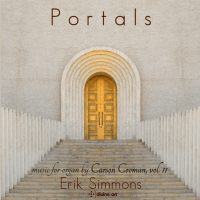Opus 1251
Organ Symphony No. 3, “Portals” (2017)
for Organ
- One Teacher
- With Thanksgiving
- Humble Yourselves
- Speak, and Do Not Be Silent
- Sing Joyfully
Erik Simmons, organ
Duration: 24 min.
Dedication: for Philip Hartmann
Commission: Commissioned by Philip Hartmann for the Martin-Luther-Kirche (Ulm, Germany)
 Recorded on Portals: Music for Organ by Carson Cooman (2019)
Recorded on Portals: Music for Organ by Carson Cooman (2019)Publisher: Zimbel Press/Subito Music Corp.
Performance materials available from the publisher.
Organ Symphony No. 3, “Portals” (2017) was written for organist Philip Hartmann in celebration of the 90th anniversary of the Martin-Luther-Kirche in Ulm, Germany. Over the five entrances of the church appear five Biblical inscriptions. These scripture passages serve as the inspiration for the five contrasting movements of this work.
1. One Teacher
“Einer ist euer Meister, Christus. Ihr aber seid alle Brüder.” (Matthäus 23,8)
“For you have one teacher, and you are all brethren.” (Matthew 23:8b)
The first movement begins with a single C. This centering pitch returns throughout the movement and symbolizes “one teacher.” The unity of all as brothers and sisters in Christ is portrayed in the harmonic material, which derives almost entirely from the harmonic series on C.
2. With Thanksgiving
“Gehet ein zu seinen Toren mit Danken.” (Psalm 100,4a)
“Enter his gates with thanksgiving.” (Psalm 100:4a)
The second movement is dance-like, with the spirit of thanksgiving portrayed with a genial mood and musette-like textures.
3. Humble Yourselves
“Demütiget euch vor Gott.” (Jakobus 4,10)
“Humble yourselves before God.” (James 4:10)
The third movement is an aria with a bit of a Celtic folk flavor. In the middle section, harmonies rise and fall with an ostinato derived from the opening melody.
4. Speak, and Do Not Be Silent
“Rede und schweige nicht, denn ich bin mit dir.” (Apostelgeschichte 18,9f)
“Speak and do not be silent, for I am with you.” (Acts 18:9c)
Grand and majestic music begins the fourth movement: a proclamation. This is developed through several key areas. After several intervening episodes, the opening music is heard again at the end of the movement. This time it sounds with full but enclosed (muted) organ colors that symbolize the inner sense of Christ’s presence: “for I am with you.”
5. Sing Joyfully
“Singet fröhlich Gott, der unsere Stärke ist.” (Psalm 81,2)
“Sing joyfully to God, who is our strength.” (Psalm 81:1)
The psalmist’s words are portrayed in the fifth movement as a joyous toccata.
